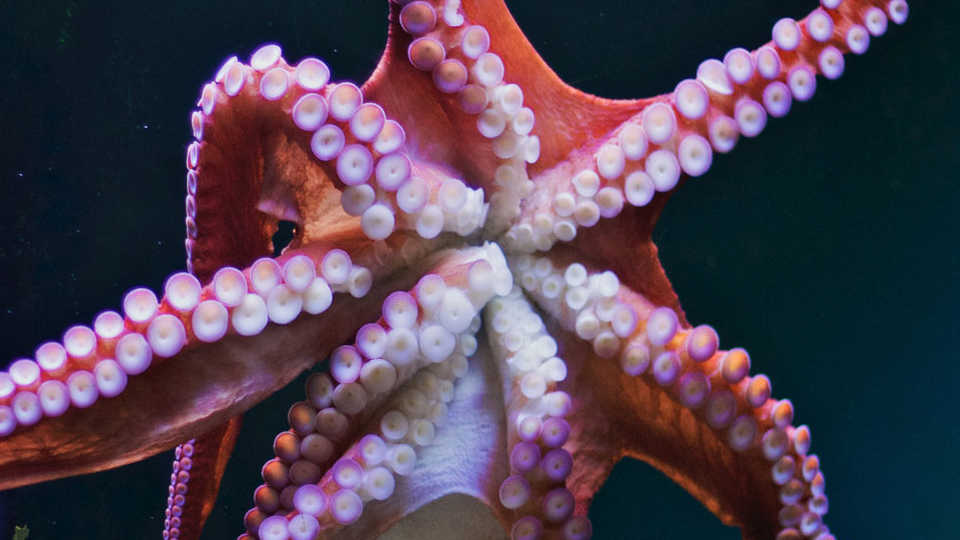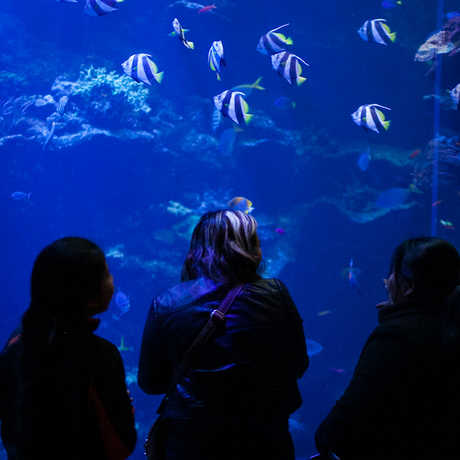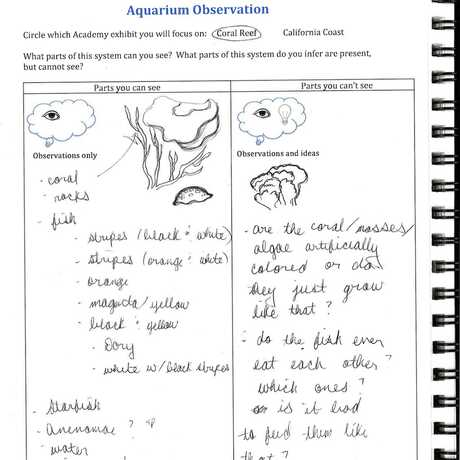
© Michael Bentley
Animals provide many ways to learn about opposites: colors, speeds, and behavior are just a few. In this activity, young scientists will practice their observational skill to look for differences among marine animals, first in a classroom and then on a field trip, and use these observations to discuss how these animals survive.
This activity is written to correspond with a field trip to the Steinhart Aquarium at the California Academy of Sciences, but can be used with a field trip to a different aquarium or to a local tidepool.
In this lesson, students will:
- compare and contrast the behavior and appearance of marine animals along the California coast.
- practice observational skills in the classroom and the Steinhart Aquarium.
- chalk board or dry erase board
- a map of California
- visual aids of Ocean Life Opposites Creatures (optional, or use your own)
- Ocean Life Opposites worksheet (1 per student)
- Ocean Life Opposites scavenger hunt (1 per student)
- pencils
- Make copies of Ocean Life Opposites worksheet (one per student).
- Print out example pictures of animals. Use the attached Ocean Life Opposites Creatures, or create your own using online search engines.
- Make Ocean Life Opposites scavenger hunt booklets.
- Make copies of the scavenger hunt (one per student).
- Fold each paper into eighths and cut along the dotted line.
- Fold each paper in half after cutting and grab the two outside panels and push them together to make an X.
- Fold the pages together to make a booklet for each student.
- Staple the binding of each journal to secure it. Teacher tip: Write students' names on them before handing them out!
- opposite: being the other of two related conditions
- observe: to notice with care using all senses
- Start the lesson by showing the students a map of California. Use your finger to trace the border of the state to represent where the California coast is located. (If you don't have one handy, you can find a map here.)
- Explain to students that they will be visiting the California Academy of Sciences and viewing the California Coast tanks in the aquarium. They will see many kinds of animals that live in the Pacific Ocean and in the rocky intertidal zone.
- Show students pictures of animals found along the California coast.
- Ask students if they can identify the animals. Review the common names of the animals.
- Ask the students what else they notice about the picture. Using questions like “is the animal in shallow or deep water?” “is it light or dark?” and “is it wet or dry?” will help prime them to use their observational skills.
- Tell students that the descriptive words you are using are opposites. Make a table on the board to show different opposite words and draw examples next to the words if possible. Discuss the differences between the words below, and feel free to add any other opposite words the students think of.
- COLD - HOT
- LIGHT - DARK
- LOW - HIGH
- OPEN - CLOSED
- FAST - SLOW
- LONG - SHORT
- TOP - BOTTOM
- IN - OUT
- Test the students’ understanding of opposites using visual aids of creatures inhabiting the California Coast.
- Show a pair of pictures to the students and ask, “Which pair of opposites do these pictures represent? Which animal is which picture?” Teacher tip: Some of the pictures may not be as obvious, so feel free to point out clues and help them out.
- Show a pair of pictures to the students and ask, “Which pair of opposites do these pictures represent? Which animal is which picture?” Teacher tip: Some of the pictures may not be as obvious, so feel free to point out clues and help them out.
- To end, hand out one Ocean Life Opposites worksheet to each student and have them complete it in class by drawing the opposite of the pictures provided. Review the answers to prepare students for the field trip.
- Hand out one scavenger hunt booklet and one pencil to each student. Teacher tip: For younger students, have chaperones be responsible for keeping the booklets and pencils in between use.
- Inform students they will use their observation skills again, but this time they will be studying live animals at the California Academy of Sciences.
- Ask students to find each organism in their journal, and circle the word that best describes what each is doing. Review the words one last time before you get started.
- Students will need to record all observations in their journals such as color, size, behavior, etc.
Discuss the data that the students collected while they were on their field trip to the California Academy of Sciences. Ask the following questions and encourage students to explain how the observations they made might relate to what the animal needs to survive, such as food, water, or a home:
- Where was the Pacific Octopus in her tank? (Was she in a crevice, which serves as a nice, safe home during the day? Or was she out and about, maybe looking for food?)
- What fish is the opposite size of the giant sea bass? (The giant sea bass is big, so maybe it eats smaller fish. The blue rockfish is small, so maybe it eats snails or worms or tiny fish.)
- Where were the moon jellies in the tank? (The moon jellies were high, because they float around in the ocean. The sea anemones were low, because they are stuck to rocks and don’t swim.)
The power of observation is an important skill. Scientists often use journals to record observations they make about an organism’s characteristics such as color, size, and behavior. When observing animals in their natural habitat, notations may have to be made quickly before they swim, fly, or run away. Fortunately, aquariums provide the opportunity to view aquatic life for longer periods of time. Animals can still hide in their aquarium habitats but there are more chances to see them up close.
Looking for opposite characteristics or behaviors can be a fun exploration for children and a way to enhance their powers of observation. In nature or the aquarium, we can search for opposites in the physical characteristics and behaviors of many animals. For example, the Pacific Octopus may hide in crevices between rocks during the day, but be out at night hunting for food. Sometimes we can find examples of opposites in one tank at one time, with different colored fish being in different areas.
Kindergarten
Life Sciences
2a. Students know how to observe and describe similarities and differences in the appearance and behavior of plants and animals.
2c. Students know how to identify major structures of common plants and animals.
Grade One
Life Sciences
- 3a. Students know different plants and animals inhabit different kinds of environments and have external features that help them thrive in difference kinds of places.
- 3b. Students know both plants and animals need water, animals need food, and plants need light.
- 3c. Students know animals eat plants or other animals for food and may also use plants or even other animals for shelter and nesting.
Investigation and Experimentation
- 4a. Draw pictures that portray some features of the thing being described.
Scientific and Engineering Practices
- Planning and Carrying Out Investigations
- Make observations or measurements to collect data that can be used to make comparisons.
- Analyzing and Interpreting Data
- Record information.
- Use and share pictures, drawings, and writings of observations.
- Use observations to describe patterns or relationships in the natural world in order to answer scientific questions.
Disciplinary Core Ideas
- LS1.A: Structure and Function: All organisms have external parts. Different animals use their body parts in different way to see, hear, grasp objects, protect themselves, move from place to place, and seek, find, and take in food, water, and air. Plants also have different parts that help them survive and grow.
- LS4.D: Biodiversity and Humans: There are many different kinds of living things in any area, and they exist in different places on land and in water.
Cross-Cutting Concepts
- Patterns: Patterns in the natural world can be observed, used to describe phenomena, and used as evidence.
- Structure and Function: The shape and stability of structures of natural objects are related to their functions.

